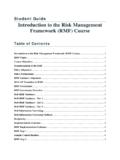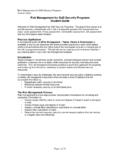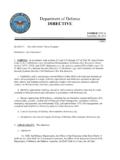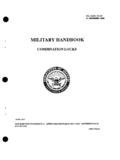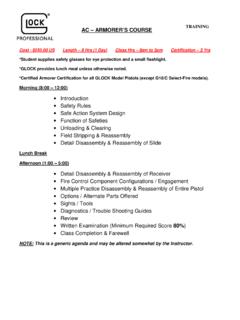Transcription of Student Guide Course: Lock and Key Systems - CDSE
1 Student Guide course : Lock and Key Systems Lesson: course Introduction course Information Purpose Provide a thorough understanding of the lock and key Systems used by the DoD Audience Military, civilian, and contractor personnel responsible for physical security Pass/Fail % 75% on final examination Estimated completion time 90 minutes course Overview Protecting DoD assets, including classified information, is imperative for our national security. Locking devices are an important part of ensuring DoD assets are protected from loss or compromise. locks are used to secure many types of doors such as doors to buildings, ammunition bunkers, storage areas and offices, safes, and filing cabinets. Security requirements for classified contracts are stated in DoD , the National Industrial Security Program Operating Manual (NISPOM). Any additional security requirements levied upon a contractor must be specifically addressed in the contract.
2 In this course you will learn about various types of lock and key Systems and their purposes as well as which ones are authorized for protecting sensitive or classified DoD assets. You will also learn how to properly protect and account for lock and key Systems . course Objectives Identify common types of locking devices Identify the primary parts of a locking device Identify considerations when choosing a lock Define master key Systems Identify types of locks used by the DoD and their purposes Identify the specifications each lock must meet, where applicable Identify the requirements and recommendations for safeguarding and changing combinations Identify the requirements and recommendations for key control Lock and Key Systems Student Guide course Introduction Page 2 course Structure course Introduction Lock and Key Basics Key-operated locks Combination locks course Conclusion Student Guide course : Lock and Key Systems Lesson.
3 Lock and Key Basics Lesson Introduction Before you learn about the specific types of locks used by the Department of Defense (DoD) and their purposes, there are some general concepts related to lock and key Systems that you should know. This lesson will familiarize you with these concepts. The lesson objectives are: Identify common types of locking devices Define master key Systems Identify the primary parts of a locking device Identify considerations when choosing a lock Overview 1. Background and Purpose Lock and key Systems are mechanical, electronic, or electromechanical devices used on doors or containers to restrict access to the area or property enclosed. Lock and key Systems have been in use for centuries. The earliest locks date back to ancient Egypt. The design used in the Pharaoh's palaces can be found in modern variations of lock design. This design consisted of a wooden housing containing wooden pegs of varying length, fitted into holes bored into the top of a wooden bolt.
4 To open the lock, a person inserted a long wooden key with pegs of specific lengths into the bolt. Today, lock and key Systems are much more sophisticated, but they serve the same functions. They are the first line of defense against unauthorized entry or theft. In this capacity, locks actually provide several different levels of deterrence. First, locks provide psychological deterrence because they can be perceived as impediments to successful intrusion. It s much easier to enter something that is not locked! locks also deter surreptitious entry. This means an intruder is less likely to be able to use stealth or secrecy to enter an area. If an area is locked, the likelihood that someone can enter without detection is pretty slim. Finally, locks provide deterrence against forced entry. A good lock requires the intruder to consider how much force would be required to break into a facility, and whether that noise could cause them to be detected and captured.
5 If a good locking mechanism is employed, it is likely the intruder will search for a less secure facility to enter. Lock and Key Systems Student Guide Lock and Key Basics Page 2 2. DoD Lock Program The DoD provides guidance to ensure that locks provide the appropriate level of protection for materials they are safeguarding. DoDM , Volumes 1 through 4, DoD information Security Program, outlines the regulations for safeguarding information which includes lock and key Systems . In addition, there are several Federal and military specifications that further outline requirements for lock and key Systems used within the DoD and by contractors for the DoD. The DoD Lock Program can also provide key information. The DoD Lock Program is designated as the technical authority for locking and storage Systems used for protection of classified information and are responsible for the management, operation, and support functions for development, testing, and procurement of locking devices and Systems used within the DoD and by contractors of the DoD.
6 You can reach the DoD Lock Program online: Lock and Key Systems 1. Types locks can be categorized in two ways. One way to think of a lock system is how it opens. That is, does it open with a key? Or with a combination? Another way to think of a lock system is whether it is fixed or portable. Is it built into a door or container? Or is it movable, like a padlock, which can easily be attached and detached? You will see key-operated built-in locks , as well as key-operated padlocks. Similarly, you will see combination built-in locks , as well as combination padlocks. Later in this course , you will learn more about specific models of locks approved for use and you will learn more about the official specifications these locks must meet. 2. Master Key Systems A master key system is a system with two or more levels of key operation where there is a single master key that fits all of the locks in a facility or group of facilities.
7 Examples of acceptable use of master key Systems in the DoD include general office areas and barracks. Let's look at how a master key system works. Let's use the example of barracks at a military installation. At this facility, there is one great grand master key that can open all of the entrances and individual room locks in the barracks on this installation. On the second level, there are two grand master keys. The first grand master key opens all of the locks in Barracks 1. The second grand master key opens all of the locks in Barracks 2. On the third level in Barracks 1, there is one master key to open all of the building entrances, another one for the living areas, and another for the storage rooms. The same is true for each type of room in Barracks 2. The primary advantage of a master key system is the convenience to its owner or manager. If someone gets locked out of their living area late at night, a facility manager can easily open it using a master key.
8 However, there are some significant disadvantages to a master key system . First, loss of the master key would require a large expense in rekeying or replacing all of the locks Lock and Key Systems Student Guide Lock and Key Basics Page 3 associated with the master key. It is also easier to make impressions of a single master key versus copying a number of individual keys. Also, it is easier to pick a master key system because there are more combinations of pin settings that can open the lock. 3. Lock Components Although there are many different types of locks , they all share three components. They are the locking device, the switching device, and the operating mechanism. The locking device is the part of the system that physically keeps the area or container secured or locked. Examples of locking devices are latches and bolts. The switching device is the element that authorizes the locking device to open.
9 Examples of switching devices include keys, cards, combinations, or biometrics such as fingerprints, iris scans, or voice recognition. The operating mechanism is the part of the system that interacts with the switching device to allow or deny entry into a given area or container. A cylinder is an example of an operating mechanism. 4. Considerations in Selecting a system When selecting a lock, there are a variety of factors to weigh. Here are some high level considerations for determining what lock and key system to use. One general principle holds true: the greater the level of protection you require, the greater the cost and level of effort your locking solution will demand. A major consideration is cost versus strength or complexity of a lock. You must weigh the cost of the lock and the level of effort to install it against the required level of security. Generally, the less expensive the lock, the easier it is to defeat.
10 The level of security you need also affects other choices. You must also consider user access to a lock. Do you want more or fewer people to have access? This affects your decision about whether to use a combination, key, access card, or biometrics. You must also consider what restrictions you want to impose on lock operation. If the lock is securing a high security item, it should remain locked at all times. If the lock is securing a low security item such as office supplies, perhaps it can remain unlocked during certain times, such as working hours. You must also consider how the door relocks. Does it close and lock automatically or do you need to lock it manually, for example with a key or by spinning a dial? When choosing a lock for a door that encloses spaces that contain people, life safety is a key consideration. The lock you use must allow people to escape in an emergency. a. Life Safety locks with emergency egress hardware, like the S&G 2980 PDL and LKM 7000, were put into practice after fatal accidents occurred in which people could not escape.
